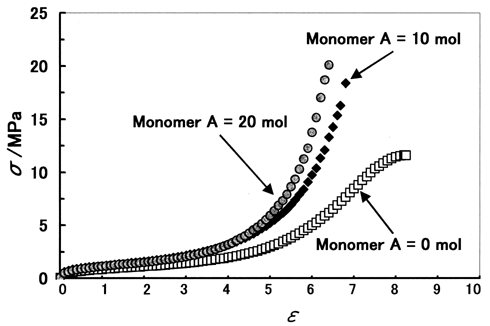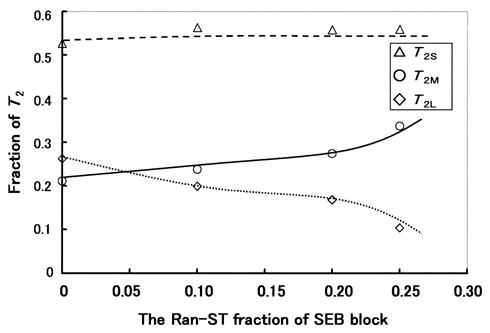 |
|
 |
|
 |
 |
|
 |
 |
| NIPPON GOMU KYOKAISHI Guidelines for Submissions (rev. 1) |
|
 |
|
|
| 1. (This section has been omitted as it deals with guidelines pertaining to Japanese language submissions.) |
| 2. Manuscript Preparation |
| |
| 2.1 |
Authors should prepare manuscripts in electronic format. |
| 2.2 |
Use A4 paper in landscape orientation, with a top and bottom margin of at least 25 mm. Text should be typed in double spacing using a 12-point type font. |
| 2.3 |
Reviews, regular papers, and technical papers should not exceed 3,800 words, including main text, figure captions, figures, and tables. Communications should not exceed 1,100 words. Figures and tables should be calculated as 150 words for single-column and 300 words for two-column.
Where the number of words stipulated is exceeded, authors will normally be requested to re-write the text. |
|
| 3. Manuscript Structure |
| |
| 3.1 |
Regular papers, technical papers, communications |
| |
| 1) |
Manuscripts should be structured according to the following sequence: |
| |
| (a) |
Page 1 should contain in English the title, name of the author, institutional affiliation, abstract (up to 200 words), and key words (up to 8 words). |
| (b) |
Page 2 onward should contain the main text (1. Introduction;
2. Experiment; 3. Results; 4. Considerations; 5. Conclusion, References).
|
| (c) |
Figure Captions |
| (d) |
Figures |
| (e) |
Tables |
However, the results and considerations may be combined into “3. Results and Considerations”. Figure captions may be written below each figure. |
| 2) |
Use either English or Japanese for the main text. Use English for references, figure captions, figures, and tables. |
| 3) |
In addition to the main text, the following should be prepared:
| (f) |
Application for Submission of Papers; and |
| (g) |
Bibliographical Information |
|
|
| 3.2 |
Reviews |
| |
| 1) |
Use the following sequence: |
| |
| (a) |
Page 1 should contain in English the title, name of the author, institutional affiliation, address, abstract (up to 200 words), and key words (up to 8 words). |
| (b) |
Page 2 onward should contain the main text (with references at the end). |
| (c) |
Figure Captions |
| (d) |
Figures |
| (e) |
Tables |
| (h) |
Explanation of Key Words |
However, figure captions may be written below each figure.
Please note that in principle English should be used for figure captions, figures, and tables.
|
| 2) |
Use either English or Japanese for the main text. |
| 3) |
In addition to the main text, the following should be prepared: |
| |
| (g) |
Bibliographical Information; and |
| (i) |
Author Career Profile (with photograph) |
|
|
|
| 4. Main Text |
| |
| 4.1 |
Please use SI units (the International System of Units). However, phr may also be employed. Please refer as appropriate to the following publication:
“Quantities, Units, and Symbols in Physical Chemistry”, Blackwell Scientific Publications, Oxford (1988) |
| 4.2 |
Where English is used for technical terms, please refer to Chemical Abstracts, IUPAC method, or ISO 1382 Rubber Vocabulary. |
| 4.3 |
In principle, names of chemical compounds should follow IUPAC Nomenclature. |
| 4.4 |
Please refer to the following Websites for chemical and structural formulae of polymers:
http://www.iupac.org/divisions/IV/IV.1/index.html
http://www.iupac.org/reports/IV/guide-for-authors.pdf |
| 4.5 |
In the case of regular papers, technical papers, and communications, trade names and company names may not be used, except where it is necessary in order to accurately describe the results of experiments.
In the case of reviews, in principle generic names should be used rather than product or company names. |
| 4.6 |
Symbols expressing numerical values in numerical formulae should be shown in italics, in accordance with the following example: |
| |
 |
(1) |
 |
(2) |
|
| |
In the main text, these should appear in a line thus: a/b, (a+b)/(c+d). Please ensure that adequate care is taken when writing numerical formulae to avoid errors. In particular, please indicate superscript and subscript clearly. When quoting formulae in the text, write thus: Equation (1),Equation (2). |
| 4.7 |
References should be numbered at the top right of where they have been used (before the period if used at the end of a sentence) in the sequence in which they appear, thus: 1); 3, 4); 5-8); then listed together at the end of the main text.
Quotations should appear in accordance with the basic method shown in the examples below (names of journals should be written in accordance with the abbreviated names in Chemical Abstracts).
With the exception of reviews, please make every effort to avoid quoting from sources that have not been reviewed.
Examples of references:
References |
| |
| 1) |
Kono, T., Otsuyama, H.: Rubber Chem. Technol., 70, 456 (1997)
|
| 2) |
Ferry,J.D.: ”Viscoelastic Properties of Polymers (3rd ed.)”, John Wiley & Sons, New York, p.503, Figure 17 (1980)
N.B.: When quoting figures and tables from books, please provide specific details. |
| 3) |
Donnet, J. J., Kono, T., Tokai, J. Trans.: "White Carbon", Maruzen, Tokyo, Chapter 6 (1996)
N.B.: When quoting entire chapters from books, please include the chapter number. |
| 4) |
Kono, T., Otsuyama, H.: Nippon Gomu Kyokai Nenjitaikai Youshisyu, 12 (2002)
N.B.: When quoting abstracts of presented papers, please specify the name of the academic conference. |
| 5) |
Kono, T.: Preprint of the 143rd Meeting of the Rubber Division, ACS, Paper No.88 (1993)
N.B.: When the abstracts of presented papers are not in booklet form, please specify the name of the academic conference, presentation reference numbers, etc. |
| 6) |
Tokai, J., Kono, T.: US Patent 7890123 (1994) |
| 7) |
Tokai, J., Kono, T.: US Patent A.P. US 2004―0654321 (2004) |
|
|
| 5. Figure |
| |
| 5.1 |
Figure captions should be listed in English on a separate sheet from the main text. Figure captions may also be written below each figure. When quoting figures in the main text, please write thus: Figure 1, Figure 2, etc.
|
| 5.2 |
Regarding the recommended style for figures, please see reference example 1. |
| 5.3 |
Please write the figures on one sheet, and enter the figure numbers at the lower right. The size of figures should not exceed 16 cm on all sides. Figures will be reduced appropriately for printing. As a rule, please convert photogravures into figures without modification. |
| 5.4 |
Photographs will also be treated as figures. |
| 5.5 |
Figures should be prepared using diagram creation software or drawing pens. |
| 5.6 |
The position where the figure is to be inserted should be indicated in the right-hand margin of the main text or between the lines. |
| 5.7 |
Explanatory notes should be entered directly onto the figure or the figure caption.
|
| 5.8 |
Figure tracing, art paper printing, color printing, etc. will incur actual expenses. |
|
| 6. Table |
| |
| 6.1 |
Tables should be numbered thus: Table 1, Table 2, etc., and should be written entirely in English, including titles and footnotes.
Please use a separate sheet for each table. |
| 6.2 |
Regarding the recommended style for tables, please see reference example 2. |
| 6.3 |
The position where the table is to be inserted should be indicated in the right-hand margin of the main text or between lines. |
|
| 7. Types of Submission |
| |
| 7.1 |
Designated types of submission should be sent to the SRIJ. |
| |
| 1) |
Regular papers, technical papers and communications:
| (a) |
Title and Abstract, etc. |
| (b) |
Main text |
| (c) |
Figure Captions(not necessary when these appear below the figures) |
| (d) |
Figures |
| (e) |
Tables |
| (f) |
Application for Submission of Papers |
| (g) |
Bibliographical Information |
Number of copies to be dispatched;
| |
(a)-(e): 2 copies (original + duplicate) |
| |
(f) and (g): 1 copy |
|
| 2) |
Reviews; (a)-(e), (g),
| (h) |
Explanation of Key Words |
| (i) |
Author Career Profile (with photograph) |
Number of copies to be dispatched;
| |
(a)-(e), (h): 2 copies (original + duplicate) |
| |
(g) and (i): 1 copy |
|
|
|
|
 |
| Reference Example 1 |
| |
 |
| |

|
| Reference Example 2 |
| |
Table 2 Physical properties of PP/SEBS
blend and PP
| |
T
B |
E
B |
T
m |
 H H |
| |
MPa |
Fraction |
K |
Jg |
 |
| PP |
22 |
0.4 |
439 |
105 |
| PP/SEBS-1 |
21 |
10.0 |
426 |
74 |
| PP/SEBS-2 |
22 |
2.7 |
426 |
75 |
| PP/SEBS-3 |
22 |
2.6 |
432 |
80 |
|
|
|
| |
Table 3 Tg obtained by Dynamic
Mechanical Analysis of PP/SEBS blend and SEBS
| Sample |
Tg/K
*1 |
Tg/K *1 |
| |
SEBS or PP |
PP/SEBS |
 |
| PP |
269 |
- |
| SEBS-1 |
237 |
244 |
| SEBS-2 |
246 |
248 |
| SEBS-3 |
248 |
249 |
| SEBS-4 |
254 |
255 |
| SEBS-5 |
259 |
259 |
|
|
*1;Tg was obtained from the peak Temperature
of tan  by the measurement of DMA
by the measurement of DMA |
| |
Table 4 Analytical data of Polymer
| |
Butylene |
Ran―St |
| |
mol |
mol |
 |
| Polymer-1 |
79 |
0 |
| Polymer-2 |
78 |
10 |
| Polymer-3 |
74 |
20 |
| Polymer-4 |
77 |
25 |
| Polymer-5 |
43 |
20 |
|
|
|
|
| |
|
 |
Copyright  THE SOCIETY OF RUBBER SCIENCE AND TECHNOLOGY, JAPAN All rights reserved. THE SOCIETY OF RUBBER SCIENCE AND TECHNOLOGY, JAPAN All rights reserved. |
|
|
|
|